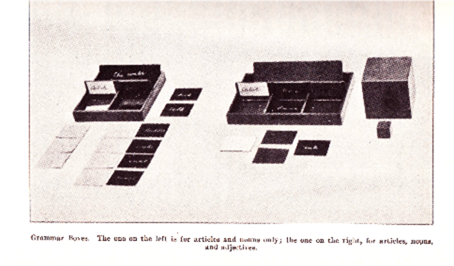

How different grammar will seem to the young pupil, if, instead of being the cruel assassin that tears the sentence to pieces so that nothing can be understood, it becomes the amiable and indispensable help to “the construction of connected discourse”! It used to be so easy to say: ” The sentence is written! Please leave it alone.’ ” Why put asunder what God has joined? Why take away from a sentence its meaning, the very thing which gave it life? Why make of it a mere mass of senseless words? Why spoil something already perfect just for the annoyance of plunging into an analysis which has no apparent purpose? Indeed, to impose upon people who can already read the task of reducing every word to its primal sounds, would be to demand of them an effort of will so gigantic that only a professional philologist could apply himself to it with the necessary diligence, and then only because he has his own particular interests and aims involved in such work. Yet the four-year-old child, when he passes from those meaningless sounds to the composition of a whole, which corresponds to an idea and represents a useful and wonderful conquest, is just as attentive as the philologist and perhaps even more enthusiastic. He will find the same joy in grammar, if, starting from analyses, it gains progressively in significance, acquiring, step by step, a greater interest, working finally up to a climax, up to the moment, that is, when the finished sentence is before him, its meaning clear and felt in its subtlest essences. The child has created something beautiful, full grown and perfect at its birth, not now to be tampered with by anybody!
The analysis of sounds which, in our method, leads to spontaneous writing, is not, to be sure, adapted to all ages. It is when the child is four or four and a half, that he shows the characteristically childlike passion for such work, which keeps him at it longer than at any other age, and leads him to develop perfection in the mechanical aspect of writing. Similarly the analytical study of parts of speech, the passionate lingering over words, is not for children of all ages. It is the children between five and seven who are the word-lovers. It is they who show a predisposition toward such study. Their undeveloped minds can not yet grasp a complete idea with distinctness. They do, however, understand words. And they may be entirely carried away by their ecstatic, their tireless interest in the parts of speech.
It is true that our whole method was born of heresy. The first departure from orthodoxy was in holding that the child can best learn to write between the ages of four and five. We are now constrained to advance another heretical proposition: children should begin the study of grammar between the ages of five and a half and seven and a half, or eight! …
[T]he child, when interested in words at a certain age, can utilize grammar to good purpose, dwelling analytically upon the various parts of speech according as the processes of his inner spiritual growth determine. In this way he comes to own his language perfectly, and to acquire some appreciation of its qualities and power.
Our grammar is not a book. The nouns (names), which the child was to place on the objects they referred to as soon as he understood their meaning, were written on cards. Similarly the words, belonging to all the other parts of speech, are written on cards. These cards are all of the same dimensions: oblongs (5 X 3 1/2 cm.) of different colors: black for the noun; tan for the article; brown for the adjective; red for the verb; pink for the adverb; violet for the preposition; yellow for the conjunction; blue for the interjection.
These cards go in special boxes, eight in number. The first box has two compartments simply; the second, however, three; the third, four; and so on down to the eighth, which is divided into nine. One wall in each section is somewhat higher than the others. This is to provide space for a card with a title describing the contents of the section. It bears, that is, the name of the relative part of speech. The title-card, furthermore, is of the same color as that used for the part of speech to which it refers. The teacher is expected to arrange these boxes so as to provide for the study of two or more parts of speech. …
Montessori, Maria. 1917 (1973). The Montessori Elementary Material. New York: Schocken Books, pp.7-11, 25. || Amazon || Worldcat
Previous || Chapter 5: Directory || Next